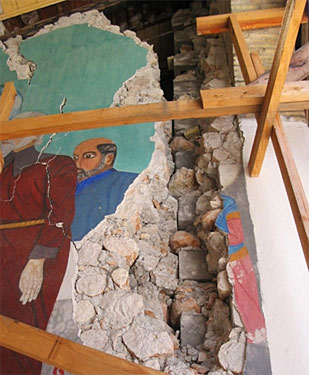Hello all!
Yes. It has been awhile. As per the title - I am a terrible person. I've also cheated on this blog somewhat (gasp!) by submitting posts to other blogs.
First and foremost - I'm currently in the process of setting up a fundraising campaign on Indiegogo to undertake a project in London, England. Yes, ladies and gentlemen, the Agar Queen has returned and she now has her sights set on the obliteration (read: gentle and controlled cleaning) of soot and smoke and other fire damage related guckies on objects involved in a tragic museum fire in Southwark.
As soon as Indiegogo, Paypal and I are done squabbling over how the money should flow from your pocket to mine, the campaign will be up and running! And, if I become a better human being in the next few months - more blog updates on the progress of the campaign and the progress of the project itself can be expected.
In matter of fact - I'm already in the process of writing a blog entry on the ins and outs of crowdfunding for conservation projects. If the campaign is successful, the blog will be called "Everything you never knew about a successful fundraising campaign" (or something equally pithy). Should the campaign be a miserable failure, the title will likely change to "What not to do when fundraising online" (though it may contain more tears...).
In terms of a little catch up - what has happened in my life since Haiti? Based on my last post, it may have seemed like I fell off the planet after that little trip. Thankfully, I have not--though not for lack of trying :)
Following Haiti, I spent a year in New Mexico, a summer in Crete, a year in Detroit and now I find myself back in the Great White North of Canada, working as both a private conservator (CLS Conservation Services at your ::cough:: service...) and in politics (I know! I know!) as a constituency assistant.
Rather than throw the entirety of the last three years at you poor souls at once - I aim/hope/would really like to/intend to (seriously guys!) plan to write up a series based on each of the locations I worked in.
In the meanwhile - here's the link to my blog entry at the Detroit Institute of Arts to tide you all over until then!
http://blog.dia.org/index.php/2013/05/cleaning-the-lost-pleiad-an-introduction/
Cheers!!
Yes. It has been awhile. As per the title - I am a terrible person. I've also cheated on this blog somewhat (gasp!) by submitting posts to other blogs.
First and foremost - I'm currently in the process of setting up a fundraising campaign on Indiegogo to undertake a project in London, England. Yes, ladies and gentlemen, the Agar Queen has returned and she now has her sights set on the obliteration (read: gentle and controlled cleaning) of soot and smoke and other fire damage related guckies on objects involved in a tragic museum fire in Southwark.
As soon as Indiegogo, Paypal and I are done squabbling over how the money should flow from your pocket to mine, the campaign will be up and running! And, if I become a better human being in the next few months - more blog updates on the progress of the campaign and the progress of the project itself can be expected.
In matter of fact - I'm already in the process of writing a blog entry on the ins and outs of crowdfunding for conservation projects. If the campaign is successful, the blog will be called "Everything you never knew about a successful fundraising campaign" (or something equally pithy). Should the campaign be a miserable failure, the title will likely change to "What not to do when fundraising online" (though it may contain more tears...).
In terms of a little catch up - what has happened in my life since Haiti? Based on my last post, it may have seemed like I fell off the planet after that little trip. Thankfully, I have not--though not for lack of trying :)
Following Haiti, I spent a year in New Mexico, a summer in Crete, a year in Detroit and now I find myself back in the Great White North of Canada, working as both a private conservator (CLS Conservation Services at your ::cough:: service...) and in politics (I know! I know!) as a constituency assistant.
Rather than throw the entirety of the last three years at you poor souls at once - I aim/hope/would really like to/intend to (seriously guys!) plan to write up a series based on each of the locations I worked in.
In the meanwhile - here's the link to my blog entry at the Detroit Institute of Arts to tide you all over until then!
http://blog.dia.org/index.php/2013/05/cleaning-the-lost-pleiad-an-introduction/
Cheers!!








































